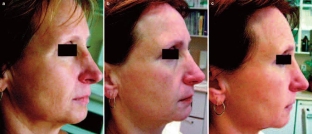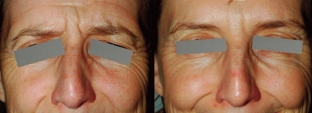A competent approach to skin rejuvenation should always be individual. Age-related changes that cause psychological discomfort for patients often cannot be corrected using just one anti-age method. To eliminate the pronounced signs of aging (deep wrinkles, significant tissue ptosis, loss of volume), mainly invasive techniques are used, which are characterized by a certain rehabilitation period.
To speed up the recovery of the skin after traumatic procedures, it is necessary to activate its regenerative abilities and natural protective functions, as well as improve the quality of the skin in general. This problem can be solved with the help of non-invasive carboxytherapy.
How does non-invasive carboxytherapy help accelerate skin recovery after traumatic procedures?
Non-invasive carboxytherapy has proven itself as a safe anti-aging procedure that can be used both to prevent signs of aging, and to eliminate existing age-related skin imperfections. In addition, carboxytherapy is successfully used in the pre-treatment and post-care stages to speed up skin recovery after invasive anti-age procedures.
The mechanism of action of carboxytherapy is extremely simple and at the same time effective: molecular CO2 after starting the carbon reaction easily penetrates the skin and due to the Bohr effect (increased ability of blood to carry oxygen due to CO 2) provides sufficient oxygen to the skin cells.
Carboxytherapy has been successfully used in the pre-treatment and post-care phases to speed up skin recovery after invasive anti-age treatments.

Carbon dioxide penetrating the skin:
- improves blood flow;
- normalizes the pH level;
- suppresses inflammation;
- provides antioxidant protection;
- provides dilatation of blood vessels;
- stimulates the synthesis of new collagen;
- promotes the elimination of toxic protein metabolites;
- stimulates skin regeneration processes;
- activates the skin's natural defense mechanisms.
Thus, due to the action of CO2, the skin is cleansed, the process of gas exchange improves, cellular metabolism increases, the regenerative and protective functions of the skin increase, the quality of the skin as a whole increases – all of these factors play an important role in recovery from traumatic procedures.
Which procedures are combined with carboxytherapy to speed up skin regeneration?
The main concerns that patients have about invasive procedures are associated with side effects, lack of efficacy and downtime.
Preparing the skin for traumatic procedures using carboxytherapy allows you to:
- increase the efficiency of invasive procedures;
- increase tolerance to invasive procedures;
- reduce the likelihood of undesirable consequences.

So, Non-Invasive Carboxytherapy can be used to accelerate skin recovery after:
- surgical rejuvenation;
- injection procedures (fillers, botulinum toxin);
- aggressive peels.
Non-invasive carboxytherapy + aesthetic surgery
Proper preparation of the skin for surgical procedures can reduce the risk of occurrence or speed of resolution of the following adverse events:
- hematoma;
- scars;
- marginal necrosis.
Carboxytherapy as a preparation for invasive procedures provides a "spring cleaning" of the skin, thereby increasing its regeneration potential, fibroblasts are activated, which in turn is necessary for the proper synthesis of extracellular matrix components (collagen, elastin, hyaluronic acid), which provide the fastest recovery of the skin after trauma.
Carboxytherapy as a preparation for invasive procedures provides a "spring cleaning" skin, thereby increasing its regeneration potential.
Non-invasive carboxytherapy + botulinum toxin injections
As a pre- and post-procedure skin care in case of rejuvenation with botulinum toxin injections, it is recommended:
- 4–10 pre-injection carboxytherapy treatments;
- 4–10 carboxytherapy treatments at least 20 days after injections.

Such a course of carboxytherapy contributes to a more rapid manifestation of the effect of botulinum therapy, as well as the launch of regeneration processes and the activation of cell function.
Non-invasive carboxytherapy + fillers
Filler injections are aimed at smoothing wrinkles and wrinkles, replenishing the volume of soft tissues. As you know, the duration of the effect of fillers after their introduction depends on several factors, including the condition of the patient's skin. Therefore, to ensure maximum effectiveness and preservation of the result after the introduction of fillers, Medicare recommends:
- for preparation: 4 – 6 non-invasive carboxytherapy treatments once a week;
- for post-care: 4–10 non-invasive carboxytherapy treatments once a week starting on day 14 after filler injections.
Non-invasive carboxytherapy + aggressive peels
Aggressive peels – another procedure that goes well with non-invasive carboxytherapy. TCA, Jessner peels, phenol and retinol peels are traumatic to the skin and require a relatively long recovery period, which can be shortened by pre-treatment in the form of a course of Medicare carboxytherapy treatments.
Read also: Comprehensive skin care program: combination of carboxytherapy and peels
Physiology, safety, efficiency, comfort during the procedure, the ability to solve a whole range of aesthetic skin problems and the combination of carboxytherapy with various anti-age procedures make non-invasive carboxytherapy from Medicare an indispensable assistant to a cosmetologist.

Intense Carboxy System helps prevent the appearance of signs of aging, fight existing age-related imperfections and accelerate skin recovery after traumatic procedures. To purchase drugs for non-invasive carboxytherapy, as well as get detailed information about skin care programs using this method, please contact the manufacturer – Medicare companies.







Add a comment